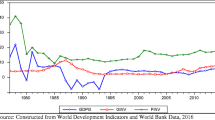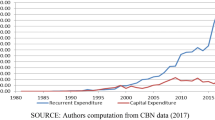Abstract
Using data for Guyana that spans the period 1980 to 2017, this study assessed the impact of efficiency-adjusted public capital on the country’s overall economic growth and expenditures for private investment. This paper contributes to the literature in four ways. First, it constructed an efficiency-adjusted and unadjusted public capital stock series for Guyana, a less developed country within the Caribbean Community, using an amended perpetual inventory model. Second, with the aid of a modified Cobb–Douglas production function, the study identified a positive connection between the efficiency-adjusted public capital stock and growth in the economy. Third, the paper shows that the adoption of the country’s Economic Recovery Program helped to boost the impact of public capital formation on the economy’s output. Finally, the paper shows that public capital growth partially crowded-out private sector investment spending in the economy which can nevertheless expand with economic growth.



Similar content being viewed by others
Notes
In this exercise, the public capital stock refers to the underlying infrastructure that would support the provision of electric power, telecommunication, water supply, sanitation and sewerage, roads and highways, irrigation and drainage, ports and waterways, airports, education, and health in an economy.
See Sturm et al. (1998) for two other approaches that can be used to look at the connection between public investment and economic growth.
The interpolation and extrapolation techniques were used, in some instances, to develop the series for variables in the study to cover the period 1980 to 2017.
To estimate the private capital stock, q is equal to 1 in the perpetual inventory formula.
For more details on Guyana’s ERP, see Egoumé-Bossogo et al. (2003).
This framework has been used extensively in time series analysis to implement the bounds test for cointegration.
Critical values for the bounds test for cointegration were extracted from Narayan (2005).
In other recent studies, estimates of the output elasticity of public capital ranged in value from 0.13 to 0.26.
The calculated F-statistic for this test was 10.35 while the value for the upper bound was 4.59 at the 5% level of significance based on Narayan (2005).
The 95 percent confidence interval for the public capital regression coefficient is between -0.40 and -0.83. Given that zero is not within the interval, the evidence shows an inverse relationship between real private investment spending and real public capital expansion. In addition, this result indicates that 95% of the time the value of the true coefficient will be in the interval of -0.40 to -0.83.
References
Arslanalp, S., Bornhorst, F., Gupta, S., & Sze, E. (2010). Public Capital and Growth, IMF Working Paper 10/175. https://doi.org/10.5089/9781455201860.001
Aschauer, D. (1989). Is public expenditure productive? Journal of Monetary Economics, 23(2), 177–200.
Bank of Guyana. (2018). Annual Report, Georgetown Guyana. Available online at: https://www.bankofguyana.org.gy/bog/research-publications/annual-report
Berlemann, M., & Wesselhoft, J. E. (2014). Estimating aggregate capital stocks using the perpetual inventory method – a survey of previous implementations and new empirical evidence for 103 countries. Review of Economics, 65(1), 1–34.
Bom, P.R.D. & Ligthart, J.E. (2009). How Productive is Public Capital? A Meta-Regression Analysis. International Studies Program Working Paper 09–12, Andrew Young School of Policy Studies, Georgia State University. Available at: https://icepp.gsu.edu/files/2015/03/ispwp0912.pdf
Caselli, F., (2005). Accounting for cross-country income differences. In: P.Aghion and S.Durlauf (eds.), Handbook of economic growth, chapter 5, 679–741.
Crivelli, E. (2020). Efficiency-adjusted public capital, capital grants, and growth. Review of Development Economics, 24(1), 254–268.
Egoumé-Bossogo, P., Faal, E., Nallari, R. & Weisman, E. (2003). Guyana: Experience with macroeconomic stabilization, structural adjustment, and poverty reduction. International Monetary Fund, Washington, D.C. Available at: https://www.imf.org/en/Publications/IMF-Special-Issues/Issues/2016/12/30/Guyana-Experience-with-Macroeconomic-Stabilization-and-Structural-Adjustment-and-Poverty-15983
Ford, R., & Poret, P. (1991). Infrastructure and private-sector productivity. OECD Economic Studies No.17, 63–89.
Gupta, S., Kangur, A., Papageorgiou, C., & Wane, A. (2014). Efficiency-adjusted public capital and growth. World Development, 57, 164–178.
Harberger, A. (1978). Perspectives on capital and technology in less developed countries. In Artis, M.J. and Nobay, A.R. (eds.), Contemporary Economic Analysis (London: Croom Helm).
International Monetary Fund. (2015). Making Public Investment More Efficient, IMF Policy Papers, Washington, D.C. https://www.imf.org/external/np/pp/eng/2015/061115.pdf
International Monetary Fund. (2019). World Economic Outlook Database. Available at: https://www.imf.org/external/pubs/ft/weo/2019/02/weodata/weoselgr.aspx
Kamps, C. (2006). New estimates of government net capital stocks for 22 OECD countries, 1960–2001, IMF Staff Papers 53(1), 120–150. Available at: https://link.springer.com/article/10.2307%2F30035911
Ligthart, J. E. (2002). Public Capital and Output Growth in Portugal: An empirical analysis. IMF Working Paper. Available at: https://www.imf.org/en/Publications/WP/Issues/2016/12/30/ Public-Capital-and-Output-Growth-in-Portugal-An-Empirical-Analysis-3414.
Munnell, A. H. (1990). Why has productivity growth declined? Productivity and public investment. New England Economic Review, Jan/Feb, 3–22. Available at: https://www.bostonfed.org/publications/new-england-economic-review/1990-issues/issue-january-february-1990/why-has-productivity-growth-declined-productivity-and-public-investment.aspx
Narayan, P. K. (2005). The saving and investment nexus for China: Evidence from cointegration tests. Applied Economics, 37, 1979–1990.
Nehru, V., & Dhareshwar, A. (1993). A new database on physical capital stock: Sources, methodology and results. Revista de Analisis Económico, 8(1), 37–59.
Pesaran, M. H., Shin, Y., & Smith, R. J. (2001). Bounds testing approaches to the analysis of level relationships. Journal of Applied Econometrics, 16, 289–326.
Pritchett, L. (2000). The tyranny of concepts: CUDIE (cumulated, depreciated, investment effort) is not capital. Journal of Economic Growth, 5, 361–384.
Romp, W., & de Haan, J. (2005). Public capital and economic growth: A Critical Survey. European Investment Bank Papers, 10(1), 40–70.
Sturm, J. E., & de Haan, J. (1995). Is public expenditure really productive? New evidence for the USA and the Netherlands. Economic Modelling, 12(1), 60–72.
Sturm J.E., G.H. Kuper, & de Haan, J. (1998). Modelling Government Investment and Economic Growth on a Macro Level: A Review. In: Brakman, S., van Ees, H., Kuipers, S.K. (eds) Market Behaviour and Macroeconomic Modelling. London: Palgrave Macmillan. https://doi.org/10.1007/978-1-349-26732-3_14
Tatom, J. A. (1991). Public capital and private sector performance. Federal Reserve Bank of St. Louis Review, 73(3), 3–15.
United Nations. (2019). Statistics Division, National Accounts. Available at: https://unstats.un.org/unsd/snaama/CountryProfile
World Bank. (2018). Worldwide Governance Indicators. Available at: https://Info.worldbank.org/governance/wgi
Author information
Authors and Affiliations
Corresponding author
Additional information
Publisher's Note
Springer Nature remains neutral with regard to jurisdictional claims in published maps and institutional affiliations.
Rights and permissions
About this article
Cite this article
Modeste, N.C. Efficiency-adjusted Public Capital and Economic Growth in Guyana: A Cointegration Analysis. Atl Econ J 49, 187–199 (2021). https://doi.org/10.1007/s11293-021-09714-5
Accepted:
Published:
Issue Date:
DOI: https://doi.org/10.1007/s11293-021-09714-5
Keywords
- Guyana
- Efficiency-adjusted public capital
- Public investment expenditures
- Private investment expenditures
- Economic growth




